the place where Paleontology and Paleoanthropology meets Philately
Estonia
Human evolution and contributors to Paleontology on stamps, postal stationeries and postmarks of Estonia
| << previous country | back to index | next country >> |
Contents:
- Country overview
- Philately of Estonia
- Some stamps of Estonia to consider
- Attention Illegal stamps !
- Postal stationery of Estonia related to Paleontology
- Some other postal stationery of Estonia to consider
- Some postmarks of Estonia to consider
- References
- Acknowledgements
Estonia, officially the Republic of Estonia, is a country in the Baltic region of Northern Europe. The territory of Estonia consists of a mainland and 2,222 islands and islets in the Baltic Sea, covering 45,339 km2 of land and water, and is influenced by a humid continental climate.
Following centuries of successive German, Danish, Swedish, and Russian rule, Estonians experienced a national awakening that culminated in independence from the Russian Empire towards the end of World War I. During World War II, Estonia was occupied by the Soviet Union in 1940, then by Nazi Germany a year later and was again annexed by the Soviets in 1944, after which it was reconstituted as the Estonian Soviet Socialist Republic. In 1988, during the Singing Revolution, the Estonian Supreme Soviet issued the Estonian Sovereignty Declaration in defiance of Soviet rule, and independence was restored on 20 August 1991. [R1]
The first Estonian stamps were put into circulation in November 1918.
From its renewed existence in 1991, Eesti Post, since 2014 also known as Omniva, issued an average of 25 to 30 different stamps, souvenir sheets and booklets a year, with an annual total face value ranging from about ten to twenty Euros. [R2]
So far there are no stamp of the country that directly related to Paleontology or Paleoanthropology.
Some stamps of Estonia to consider: sequence of human evolution
| 09.05.2016 "Europa: Think greed" [O1] | ||
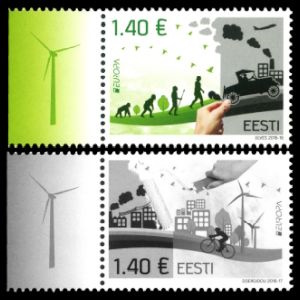 |
|
|
Notes:

|
|
Human evolution on Europa Think Green stamps of Serbia and Estonia. Estonia MiNr.: 861 Scott: 814, Serbia MiNr.: 667 Scott: 741 |
All of the countries that participated in the theme issued the same stamp (a picture of a cyclist riding past a series of wind turbines). Some countries, including Estonia and Serbian, issued a second stamp in the set. Estonia and Serbia both issued Europa stamps showing a stylized view of the march of progress in human evolution.
"On the stamp the artist shows that work made man from the ape, but what man has done with his wisdom…? In addition to human development and factories with smoking chimneys the stamp features the world’s first affordable and thus mass-produced car, Ford Model T"
Attention: Illegal stamps !
An illegal stamp is defined by the Universal Postal Union (UPU) as a stamp that carries the name of a legitimate country or territory but was not produced or printed by the postal administration of that country and is not valid for postage anywhere in the world.| 2000 - "Stones and Minerals" [F1] | ||
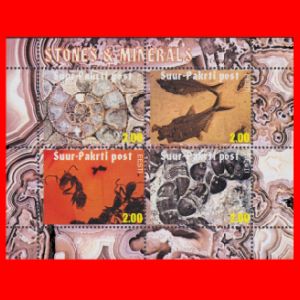 |
|
|
Notes:
[F1] According to Colnect philatelic database, this Mini-Sheet is a part of set of five Mini-Sheets "Stones and Minerals", issued by Suur-Pakrti post in 2000. The year of issue and the currency are missing on these stamps - a very common practice for illegal stamps. This practice allows people behind the production to avoid legal actions against them, by declaring their products as "stamps like labels" or "artist stamps".
The name of the "post company", Suur-Pakrti, recalls "Suur-Pakri" - the name of one of Estonian islands.
Suur-Pakri and Vaike-Pakri are two Estonian islands in the Finnish Gulf known as
Pakri Islands.
Before the Second World War the two islands had 5 villages,
three on Suur-Pakri and two on Vaike-Pakri, with a total population of about 500 persons.
According to Wikipedia, in 2009 the population of both islands was 6 persons only.
[R4]
All "stamps" of Suur-Pakrti post has been denounced in Estonia 2007 UPU Circular 200 as illegally produced without the authorization of the postal administration:
Estonian Post Ltd. has been receiving numerous messages from philatelists
around the world asking it to confirm the validity of postage stamps being sold on
the Internet that bear the names of Estonian islands.
Under the national legislation of the Republic of Estonia, the sole body authorized
to issue postage stamps is Estonian Post Ltd.
No other legal company in Estonia may issue postage stamps featuring the names
of Estonian islands.
We can therefore confirm that these stamps have not been officially issued and are
not valid for postage.
We strongly denounce and condemn such illegal activity...
Commemorative postal stationery of Estonia related to Paleontology: fossils
| 1928 | ||
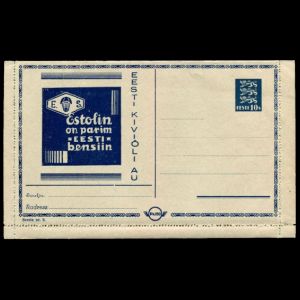 |
|
|
Other commemorative postal stationery of Estonia to consider: contributors to Paleontology science
| 2003 "150th anniversary of Estonian Naturalist's Society" [PSO1] | 2017 "225th anniversary of Karl Ernst von Baer" [PSO1] | |
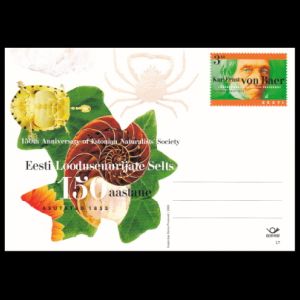 |
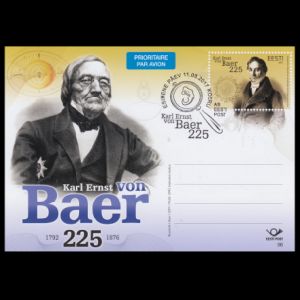 |
|
Notes:
[PSO1] Karl Ernst von Baer (1792 – 1876),
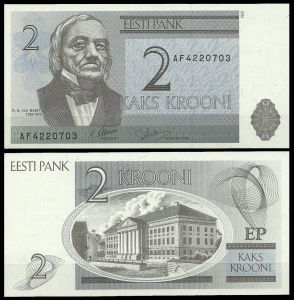
Karl Ernst von Baer on banknote of Estonia: 2 Krone 1992-2010 |
He was a member of the Russian Academy of Sciences, a co-founder of the Russian Geographical Society, and the first president of the Russian Entomological Society, making him a distinguished Baltic German scientist.
When the first fully preserved skeleton of a woolly mammoth brought to St. Petersburg Academy of Sciences by Michael Adams in 1806.
The Adams mammoth is the first woolly mammoth skeleton with skin and flesh still attached to be recovered by scientists.
The mostly complete skeleton and flesh were discovered in 1799 in northeastern Siberia by Ossip Shumachov,
an Evenki hunter and subsequently recovered in 1806 when Russian botanist Mikhail Adams journeyed to the location and collected the remains.
It was Baer’s guess that mammoth corpses could survive for several thousands of years but only in permafrost.
Adams’s report on the conditions of the site where the mammoth was found was contradictory. Baer was unable to understand how the mammoth came to be there. He thought that there were three possibilities: it was located on an iceberg, it was in ice heaped up on the shore of a river, or it had melted from an ice-wall covered with soil.
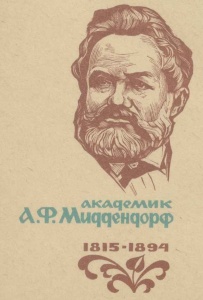
Alexander Theodor von Middendorff on postal stationery of USSR 1965 |
To clarify it, he organized an expedition to Siberia, headed by Alexander Theodor von Middendorff that took place between 1842 and 1845. One of the most important questions to be answered by Middendorff’s expedition, according to Baer, was to fix as exactly as possible the physico-geographic and geologic conditions at the site at which Adams’ mammoth had been found, Cape Bykovski in Siberia.
Unfortunately, Middendorff was unable to find any new information about Adam's Mammoth, as to much time had passed since it was found in 1799. However, he discovered and described remnants of another mammoth on the Taymyr peninsula (at Nizhnaya-Taymyr River).
At the end of the 1850s, he began to analyse the material he had collected. He compiled an historical review of all similar finds in Siberia concluding that, in the past, mammoths had lived in the central and southern regions of Siberia, in climatic conditions quite similar to those of his time.
In 1866 Baer publish an article "Neue Auffindung eines vollständiges Mammuts, mit der Haut und den Weichtheilen, im Eisboden Sibiriens, in den Nähe der Bucht des Tas" (New discovery of a complete mammoth, with its skin and soft parts, in the ice floor of Siberia, near the Bay of the Tas) about the Mammoth, discovered by another Baltic German scientist Carl Friedrich Schmidt.
Carl Friedrich Schmidt, sometimes called just Friedrich Schmidt (1832-1908) was a geologist and botanist
in the Russian Empire and also known as the founder of Estonian geology, who described the stratigraphy and fauna of
Lower Paleozoic rocks in Estonia and neighboring areas.
In 1859-1866 Schmidt participated in several expeditions in Siberia.
In 1866 he guided an expedition of the Russian Science Academy to Siberia to describe and collect Mammoth remains, discovered at Enisej river.
In 1869 he described his discovery of the Mammoth in the article "Mittheilungen über die wissenschaftlichen Resultate der Expedition zur
Aufsuchung eines angekündigten Mammuthcadavers" (Report about the scientific results of the expedition to Search for an announced mammoth cadaver)
Some commemorative postmarks of Estonia to consider: contributors to Paleontology science
| 28.02.1992 "200th anniversary of Karl Ernst von Baer" [Sp] [PSO1] | ||
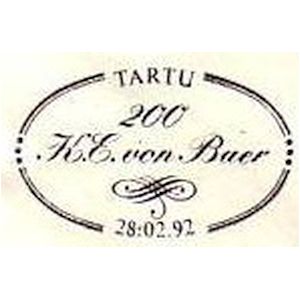 |
|
|
References:
- [R1] Estonia: Wikipedia WikiTravel FlagCounter
- [R2] Postal History and Philately of Estonia:
Wikipedia
Links to official website of the Post Authority, stamp catalog and a list of new stamps of Estonia are here - [R3] Karl Ernst von Baer:
Wikipedia,
Adam's mammoth,
Carl Friedrich Schmidt,
" Siberian Woolly Mammoths and Studies into Permafrost in the Russian Empire in the 19th Century" by Erki Tammiksaar and Ken Kalling from Centre for Science Studies, Estonian University of Life Sciences
" Alexander von Middendorff and his expedition to Siberia (1842–1845)" by Erki Tammiksaar from Centre for Science Studies, Estonian University of Life Sciences and Ian R. Stone Scott Polar Research Institute, University of Cambridge. - [R4] Illegal stamps of Estonia:
Estonia 2007 UPU Circular 200,
Colnect.
- Suur-Pakri island: Wikipedia.
Acknowledgements:
Many thanks to Dr. Peter Voice from Department of Geological and Environmental Sciences, Western Michigan University, for the draft page review and his very valuable comments.
| << previous country | back to index | next country >> |